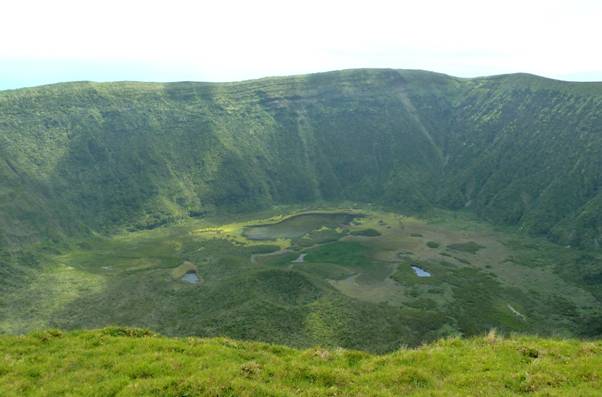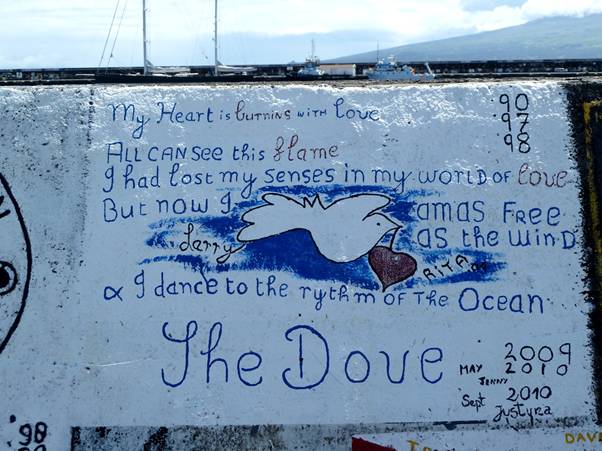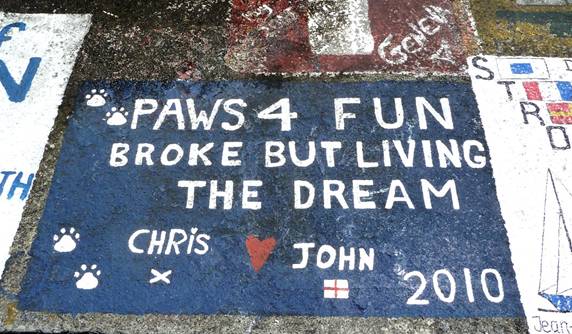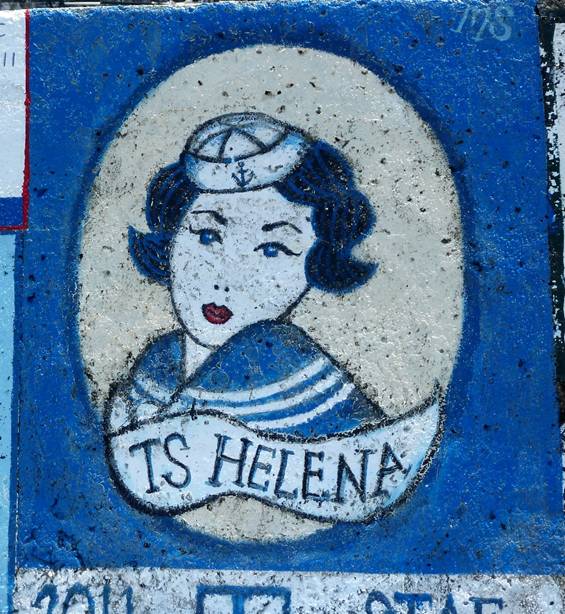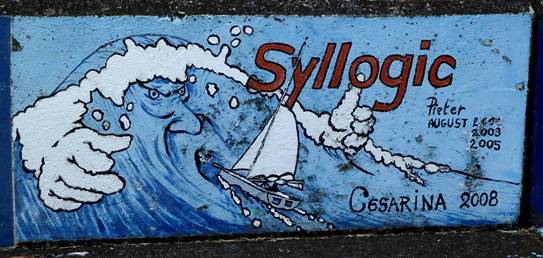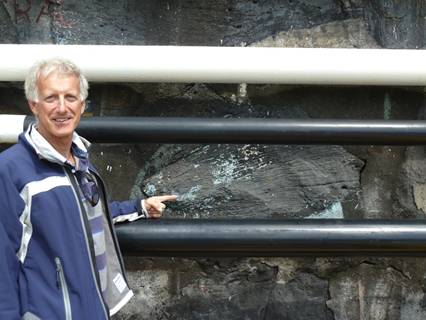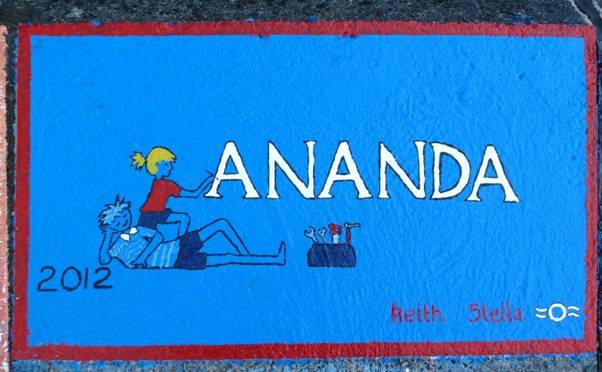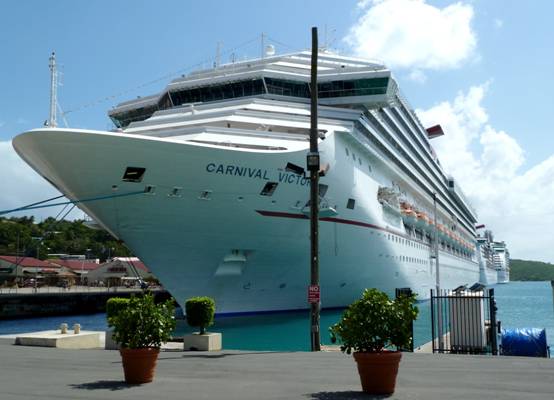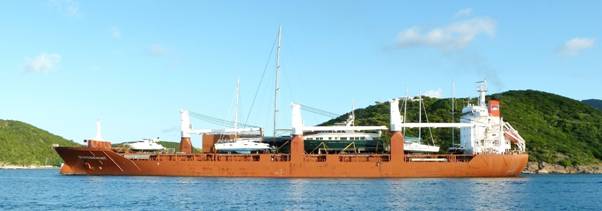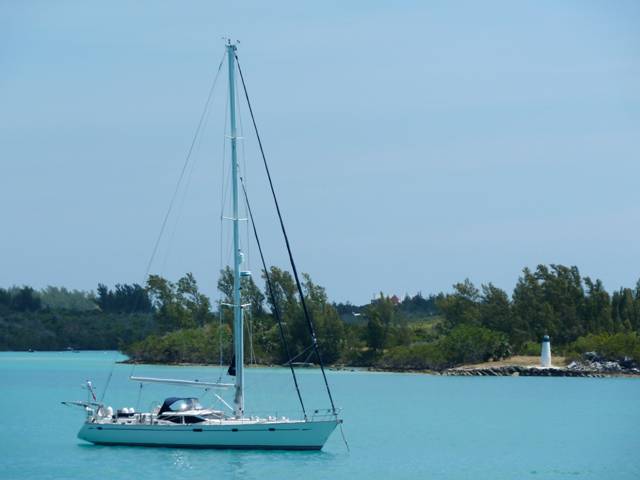For most transatlantic sailors it's the passage back to Europe that holds the greatest challenge.
When crossing over to the Caribbean there's a good chance of enjoying constant trade winds to roll you over thousands of miles of empty ocean. But try and sail in the other direction and the weather you get is complete pot-luck.
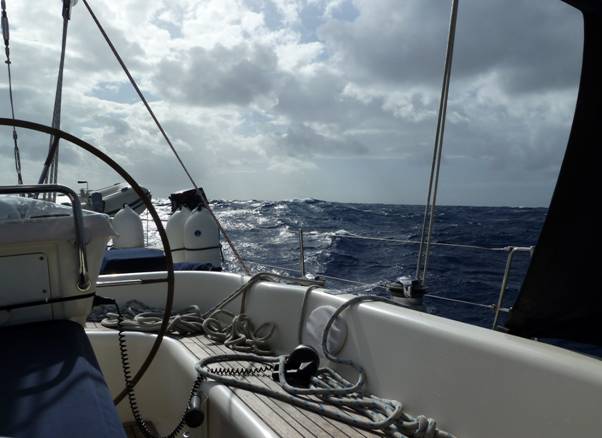 |
| Leaving Bermuda on the back of a depression with rather lumpy seas |
So after a quick dive under the boat to change an anode on the propeller shaft, we took on fresh water and diesel and motored out through St Georges cut into the Atlantic. It was hard to leave Bermuda, almost a second abode for us now, but we were excited to be heading for our real home. And we had company – at least for a while. The 65' yacht Windrose, a beautiful Hoek design combining traditional looks with a modern underwater profile for speed and performance, left Bermuda at the same time. On board were 4 friendly crew, all from the Azores, delivering the yacht for her Portuguese owner. Surprisingly we sailed close enough together for regular chats on VHF for almost a week.
The journey was not an easy one. Despite many challenges, not least of which was the weather, our passage was no more difficult than that experienced by most of the other sailors who crossed at the same time. Rather than take the more direct northerly route to the Azores, we were pushed further and further south to avoid strong head winds as one depression after another tracked eastward across the Atlantic. Fortunately we could just about maintain radio contact with weather guru Herb in Canada – thanks Herb for your generous help!
Our sails were rather a headache. The 'phantom slasher' was back at work and we found yet more new tears in our genoa. During a calmer spell we dropped the sail to the deck and made temporary repairs with sticky-backed sailcloth, but what was it that kept damaging our lovely new genoa? We had already virtually smothered the mast and spreaders with plastic tape to protect the sail from harm, but to no avail.
It was Stella who finally provided the answer - it was the staysail! Fitted with metal battens when new, the staysail's batten pockets had worn away, exposing razor sharp metal edges that slashed away at the genoa whenever it brushed past. So we dropped the staysail too and removed the offending battens – hopefully now the end of this particular saga.
More seriously, we developed a 2 metre tear along the foot of the mainsail. We sailed under jib alone for a few days until conditions allowed us to drop and stow this heavy sail. But when we did, we found another problem. A large bolt had dropped out of the in-mast furling mechanism and disappeared overboard, rendering it unusable. So even though we had a spare mainsail, we would not be able to set it.
Time for some improvisation…
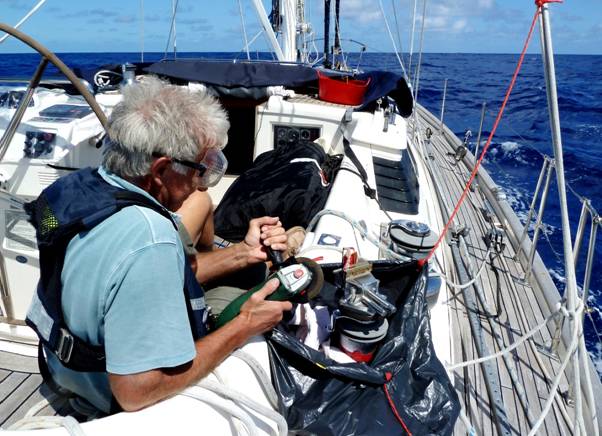 |
| With the help of an angle grinder, a temporary 10mm locating grub screw is fashioned... |
…and then we hoist our spare laminated mainsail…
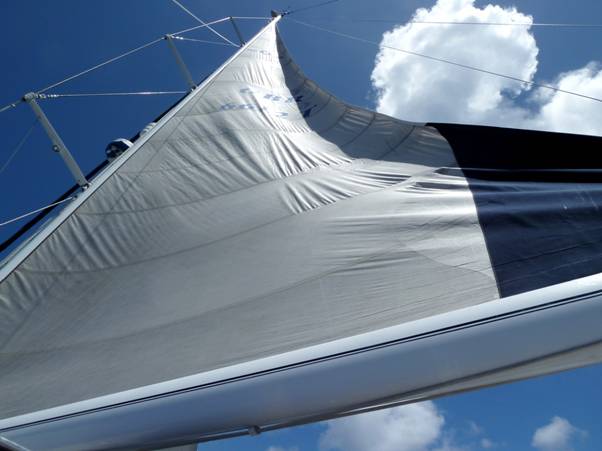 |
| ... but oh dear! Left in a locker, the laminated sail has come unstuck and imaginatively reformed itself into a sack of potatoes. |
Having worked so far south, we were now left with a 500 mile beat to windward to reach the Azores and a sack-of-potatoes mainsail that was not a great help in these conditions. We pushed on, until there was only 200 miles to go. Then came news of yet another approaching depression. But at this stage the possibility of being safely snuggled up in a comfortable harbour rather than receiving another lashing from wind and waves, proved far too tempting. So we resorted to the 'iron genoa'. The engine performed flawlessly, pushing Ananda steadily into the 4m swell.
The VHF sprang to life with a call from another yacht, and there close behind us was Deep Blue, a Swan 57. The Norwegian owner 'Captain Flash' told us he had sailed directly from the Caribbean though, it would seem, not without problems. We looked forward to meeting up in Horta.
.
 |
| Captain Flash on Deep Blue, beating into the ocean swell. |
As the sky lightened in the early dawn we could see the towering summit of Pico close ahead. Then the lights of the harbour of Horta on the neighbouring island of Faial came into view and, after 15 days at sea, we were relieved to reach the lights of civilisation. And we would have the opportunity to settle our sleep debt too.
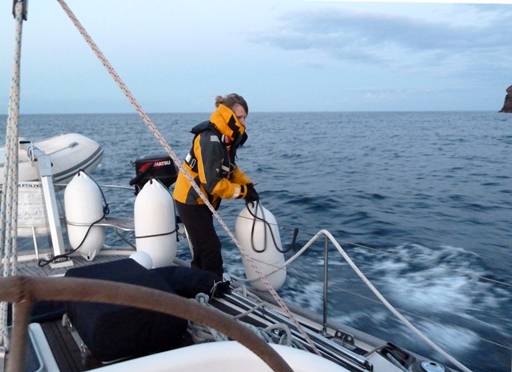 |
| Approaching Horta at dawn - time to set mooring ropes and fenders. |
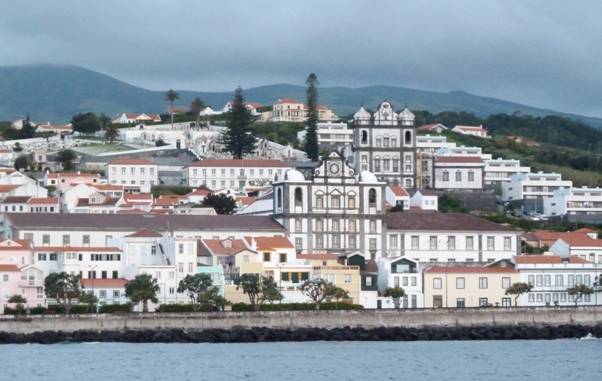 |
| Horta, Faial, somewhat rebuilt after being burnt to the ground by the Earl of Cumberland in 1589 and again by Sir Walter Raleigh in September 1597. In those days the island was under Spanish rule. |
Ashore in Horta, there was a welcoming closeness and camaraderie amongst the yachtsmen in the harbour that was quite unusual. Amongst the first arrivals of the season, we sailors had been through quite a lot in order to just be there. And having experienced such unseasonably bad weather for May it seemed that everyone had a tale to tell. And we had got off fairly lightly.
There was a steady influx of yachts with foresails in tatters, remnants streaming out from forestays like ribbons. Roller furling mechanisms were dismantled and laid along the quaysides, crews busy with saws and drills. Captain flash had nursed an extremely sick crew member in a curtained-off area of the yacht's saloon for 3 weeks. Diagnosed over the radio by emergency services as having Denghe Fever, the crew lost much body weight and medical evacuation was considered on 3 occasions. And on top of this, the yacht's rudder was becoming detached, making the vessel's motion awkward and its safety uncertain. Fortunately the crew member made a good recovery, sufficient to remain onboard for the voyage back to Norway.
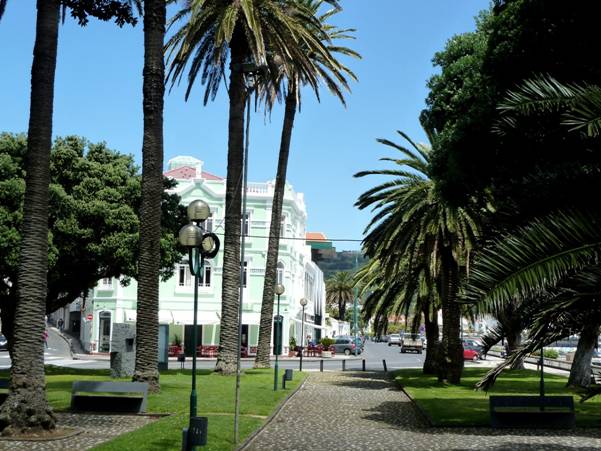 |
| Praca do Infante, Faial |
Worse still, when one American yacht arrived in harbour during a particularly bad blow, it became disabled and was blown onto the rocks in full view of all. The yacht was holed and completely awash, but fortunately the terrified crew were rescued unharmed. A salvage boat hauled it off the rocks once and then a second time after the tow-line parted, then the yacht was very quickly slipped at the boatyard. But the damage appeared irretrievable – half of the rudder missing and multiple holes over one side of the hull. A sad end to what was probably a trip of a lifetime.
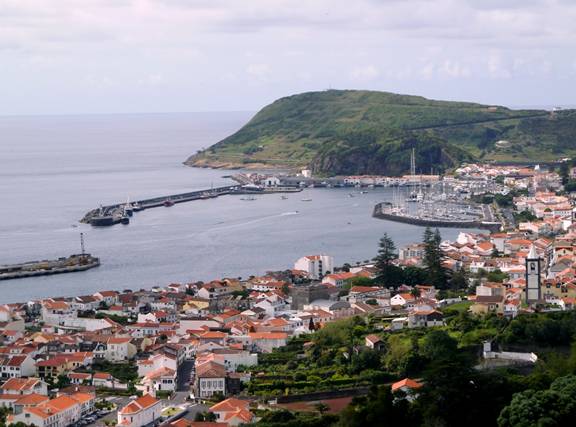 |
| The harbour and marina at Horta. On the left of the picture, a new breakwater under construction can be seen. |
The harbour had changed considerably since our original visit here in 1989 on Coot, our 30 foot sloop. In those days there was no marina and visiting yachts tied up on the inside of the original 1876 breakwater. Now there are 2 yacht basins, a fishing harbour, container port and slipway.
Still the warmth and friendliness of the locals still shines through. That favourite yachtsman's haunt Café Sport, Peter's wonderful bar, is still there, though nowadays it is run by Peter's son, Jose. But sadly the main problem for the islanders also remains much the same – a lack of employment opportunities that leads to a high emigration rate.
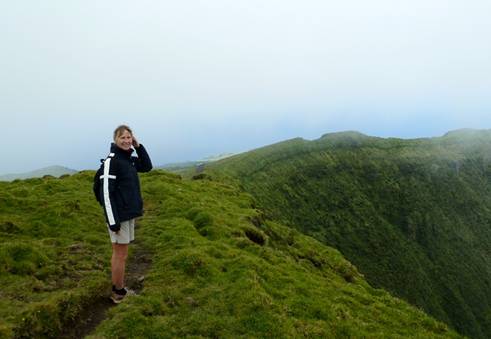 |
| A pretty spectacular ridge walk. |
In September 1957, the first major volcanic eruption for nearly 3 centuries occurred on the island. It started 1km out at sea off Ponta dos Capelinhos on the western tip of the island, and soon the lighthouse on the point was half buried by ash and pumice. A new island nearly 100m high formed close by, and then further eruptions joined the island to the mainland and increased its height to 144m. 15,000 people, nearly half of the island's population took the decision to emigrate, many to the USA.
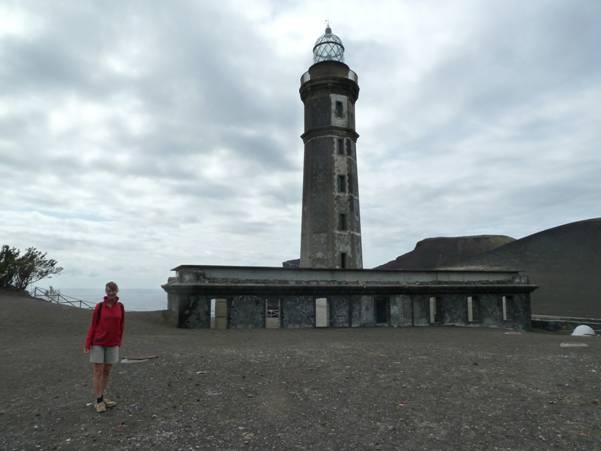 |
| Capelinhos lighthouse. It is actually a 2 storey building but the first floor is now covered with ash. |
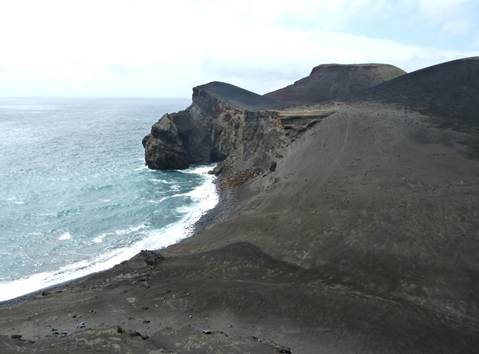 |
| The new volcanic peninsula at Capelinhos. |
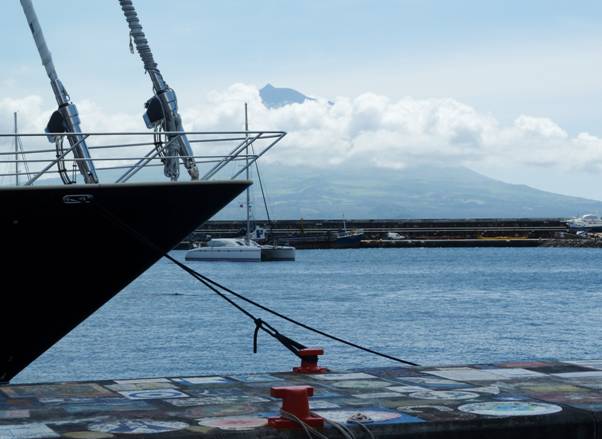 |
| Lofty heights: the rarely seen summit of Pico at 2351m and the bow of superyacht Parsifal 3. |
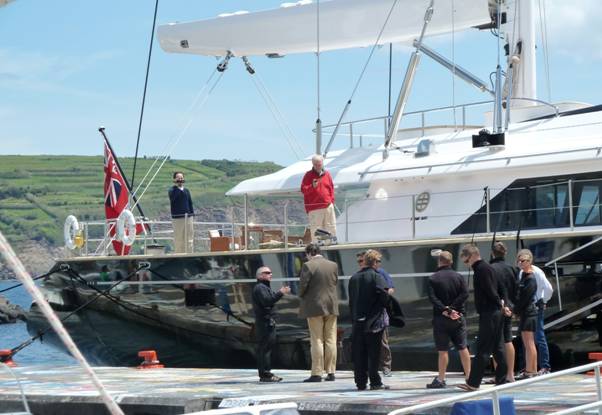 |
| Who he? Mr Big receives deferential treatment from the crew of Parsifal. |
No visit to Horta is complete without a yachtsman leaving a painting of his yacht's name on the quayside or breakwater wall. Indeed it is considered bad luck to leave the island without having done so; it would appear that we yachtsmen are a superstitious lot. The locals not only condone but encourage it, viewing such defacement as an art form rather than vandalism.
 |
| Leaving in style. The breakwater with yachtsmen's paintings can be seen behind the schooner's stern. |
The wharfs around the harbour were a hive of activity, a kind of nautical renaissance. Artists were camped out at intervals, industriously designing their masterpieces under the scrutiny of passers-by offering advice and encouragement. Paint pots were passed on from boat to boat.
Some artists really managed to capture the philosophy of cruising …
Others displayed the more traditional saucier side of a sailor's life…
The parlous nature of most cruising yachtsmen's finances shone through…
…as well as the sailor's longing for his shore side gal.
The inherent dangers of a cruising life and the power of the sea were common themes.
Amazingly, after 33 years, the original painting that Stella made on our last visit is still there – at least traces of it! The pipes were not present in 1979 but have probably contributed to the painting's longevity.
Finally, after braving the wind and showers, Stellie made the finishing touches to our new painting.
Just about sums us up, don't you think?
A few minutes later we cast off our lines to head once again towards home.
* * * * *
